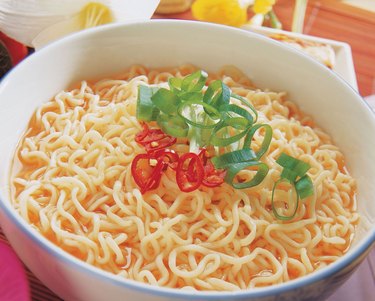
Mr. Noodles is a Canadian brand of instant ramen noodles imported by Vancouver's Anderson Watts, Ltd. These noodles, made by Beltek Foods of Huizhou, China, come in a number of different flavors, including beef, chicken, oriental and vegetable.
Preparation and Serving Size
Video of the Day
Like most instant noodles, a package of Mr. Noodles contains a block of pre-cooked, fried ramen noodles with at least one packet of seasoning, often with a second packet containing dried vegetables. Despite differences in serving size, the nutrition per gram contained in a package of Mr. Noodles does not differ from that in a cup of Mr. Noodles. Similarly, the nutritional content of a 43 gram, or 1/2 package, serving varies little between flavors.
Video of the Day
Chicken Flavor
One 43 gram serving of Mr. Noodles chicken flavor instant noodles contains 190 calories, 54 of which come from fat. Based on a 2000 calorie per day diet, one serving contains 15 percent, or 3 grams, of your recommended daily intake of saturated fat in the package's total 6 grams of fat, or 9 percent of your RDI. Although one serving contains 0 mg of cholesterol, the 980 mg of sodium constitutes 41 percent of your RDI. Of the 27 grams, or 9 percent of your RDI, of carbohydrates, 0.5 grams are dietary fiber and 3 grams are sugar, with an additional 4 grams of the packet representing 8% of your RDI of protein. Aside from 6 percent of your RDI of iron and 1 percent of your calcium intake, the vitamin and mineral content in one serving is negligible.
Vegetable Flavor
Similar to the chicken flavor, one serving of vegetable flavor Mr. Noodles contains 190 calories, with 54 coming from fat. Though both contain 6 grams of fat, the vegetable flavor contains slightly less saturated fat, with 2.5 grams or 12 percent of your RDI. Also containing 0 mg of cholesterol, the vegetable flavor's 1020 mg of sodium represents 42 percent of your RDI, a slight increase over that of the chicken flavor. Though both flavors contain 0.5 grams of dietary fiber and 9 percent of your RDI of carbohydrates, the vegetable flavor contains only 1 gram of sugar. Although the vegetable flavor contains slightly less iron than the chicken flavor with 4 percent of your RDI, both flavors contain 4 grams of protein and 1 percent of your RDI of calcium, with all other mineral and vegetable content negligible.
Oriental Flavor
One serving of the oriental flavor contains 63 calories from fat in its 190 calories. With 7 grams, or 11 percent of your RDI, of total fat and 3.5 grams, or 18 percent, of saturated fat, one serving of the oriental flavor is considerably less healthy than the other flavors. This trend continues in the 1320 mg of sodium, constituting 55 percent of your RDI. One serving of oriental Mr. Noodles contains 27 grams of carbohydrates, 0.5 grams of dietary fiber, 4 grams of protein and 1 percent of your RDI of calcium. Though not identical, such similarities continue in the oriental flavor's 2 grams of sugar, 5 percent of your RDI of iron and otherwise negligible vitamin and mineral content.
Beef Flavor
With 59 of its 190 calories coming from fat, one serving of beef flavor Mr. Noodles contains 6.5 grams, or 10 percent of your RDI, of fat and 3 grams, or 15 percent of saturated fat. With 900 mg, or 38 percent, of sodium, the beef flavor has considerably lower sodium content than the oriental flavor and slightly more carbohydrates, with 28 grams. Otherwise, the two flavors are nearly identical: both contain 0.5 grams of dietary fiber, 2 grams of sugar, 4 grams of protein, 5 percent of your RDI of iron, 1 percent of your RDI of calcium and otherwise negligible vitamin and mineral content.
Recommendations
As is apparent from differences between the different flavors, the majority of the variability in nutritional content comes from the flavoring packets. With all flavors nearly identical in all respects but sodium and saturated fat content, you may want to either use less of the flavoring packet or eliminate it altogether if you are monitoring your fat or sodium intake.